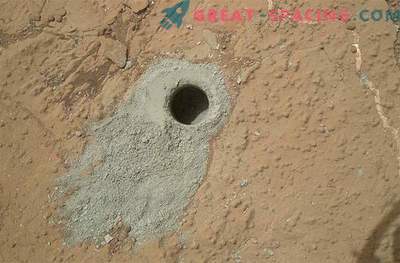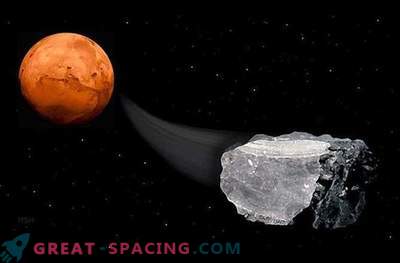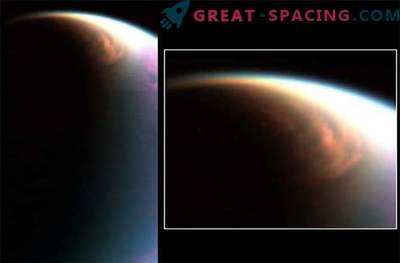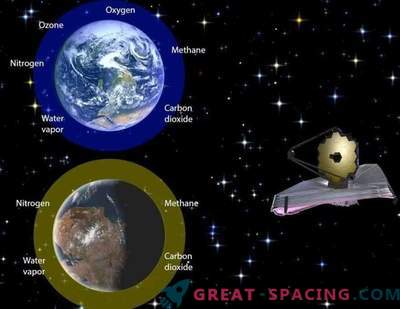
Scientists have been asking this question for about 50 years, since the moment when the spacecraft Mariner 7 discovered traces of this gas near the south pole of Mars. A month later, the researchers abandoned this conclusion, realizing that the signal actually came from dry ice (carbon dioxide).
Then in 2003 and 2004, ground-based telescopes and an orbiter again revived the mystery of this phenomenon, reporting large methane clouds in the atmosphere of Mars. Most of the methane on Earth is produced by living organisms, although in small quantities it can form when the rock interacts with hot water. Methane emissions on Mars would mean that the planet is perhaps more alive than previously thought, either biologically or geologically. Here are just a “jet” mysteriously disappeared several years later, causing a heated discussion about whether they are a seasonal phenomenon, or the results of poor-quality research.
Everyone was hoping that NASA's Curiosity rover would resolve this issue. He investigated the atmospheric samples of Mars for the presence of methane six times from October 2012 to June 2013, but he did not find anything. And yet, the question of Martian methane remained open. A few months later, Curiosity recorded a sudden outburst of gas in the results of four surveys over a period of two months.
Trying to eliminate any anomalies, and constantly monitoring the development of emissions, the Curiosity team waited a whole year before announcing new results at the meeting of the American Geophysical Union in December 2014. These studies were published in the journal Science in January 2015. Whether microbes hiding under surface of Mars, or geological activity, to some extent the Red Planet could well be alive. Yet one of the researchers is skeptical about such conclusions. Kevin Zanle, a NASA Ames Research Center scientist who did not participate in the discovery, expressed his views on this matter last month at a seminar at the NASA Laboratory of Virtual Planets at the Institute of Astrobiology.
“I’m convinced that they actually see methane,” he said. “But I think it comes from the rover itself.”
Methane from Earth
Zanle, who criticized also reports of methane in 2003 and 2004, said that the rover could very easily mislead scientists. In the end, the concentration of methane in the chamber of the rover itself is a thousand times greater than in the estimated cloud in the atmosphere of Mars. Methane on Curiosity is taken from Earth.
Immediately after landing in the Gale crater, the tunable laser spectrometer showed an extremely high level of methane. Scientists of the group quickly realized that during their stay at the launch platform of the US Air Force Base at Cape Canaveral (Florida), the ground air was leaking into the device. They pumped out most of this methane, leaving a small amount in the prechamber as a test sample.
And yet, the Curiosity team continues to insist that this source did not affect the discovery.
“We are constantly following this amount of methane, and have never noticed any evidence of a leak during our entire mission,” said Chris Webster, lead scientist at NASA's Jet Propulsion Laboratory in Pasadena, California, and chief author of a recent study on methane on Mars. "Although it is true that the concentration of methane in the chamber is 1000 times higher than its concentration in the atmosphere of Mars, it is precisely the comparison of them that is misleading." “We need to look at the amount of methane, not the concentration,” he explained. “The concentration of methane in the rover may seem high, but in fact it is very small, because the camera is small. To produce the amount of methane that we noticed in the atmosphere of Mars, we need a whole gas cylinder with pure methane, which leaks from the rover. We just don't have one. ”
Unknown sources?
Zanle also claims that terrestrial air could penetrate into other compartments of the rover.
“It’s very difficult to completely eliminate the rover as a source,” he said. “You need to know all the places where methane can be stored.”
Chris McKay, NASA researcher at Ames and co-author of the January study, considers Zanle’s doubts to be fair. “I think that it is necessary to continue to consider the possibility of locating the source of methane on board until it is completely refuted,” he said.
However, Paul Mahaffi, the chief scientist on the Mars sample design team using the SAM toolkit, doubts that the rover could be the source. “It is unlikely that after a year of being on the surface of Mars, a source of methane will suddenly appear on board the ship, which will last 60 days in the atmosphere and then disappear,” he said. “Methane is a very volatile gas, and any of its remnants brought to Mars would have disappeared long ago.”
Webster agrees that the existence of an unknown source on board seems incredible, but claims that it is quite possible.
“There are several sealed compartments on the ship,” he said. “Theoretically, they could be a source if some methane fell into them and then began to leak. But we all searched and found nothing. ”
What's next?
Curiosity is preparing for new research this year closer to the holiday season. It was at this time that the mysterious methane emission was discovered in 2013 (one “Mars” a year ago). “If methane appears again at the same time, it will be possible to say something about a seasonal phenomenon,” said Webster. “This will be a great discovery and will leave in the past questions about a possible source on the rover.”
At the same time, McKay is exploring another possibility, namely that a meteorite could have recently fallen close to the rover. The composition of carbon meteorites is a small amount of organic matter that can emit a stream of methane during destruction under the action of ultraviolet radiation.
“Of course, this is unlikely, but it happens,” said McKay. “If the rover were in the city of Marchison (New Zealand) in 1969, when a meteorite fell, it would have detected a methane release.”
The Curiosity team was looking for fresh craters near the rover, exploring images taken from orbit. And I did not find anything. Despite this, McKay notes that, in contrast to iron-stone meteorites, carbonaceous ones do not leave behind craters. Instead, they tend to decay in the atmosphere and fall as rain from small organic compounds. McKay is currently working in tandem with an expert on meteorites to determine the size of an object that may have caused a methane surge, discovered by Curiosity.
The ExoMars Trace Gas Orbiter (a new mission led by the European Space Agency, which is scheduled for launch in 2016) is also carefully examining the Martian atmosphere for traces of methane and other exotic gases. At present, the Indian mission to Mars is in orbit, which may soon report on the results of its research. Both missions will explore the area much larger than that studied by the Curiosity rover, which will spend its entire life in the Gale crater. Will they, in the end, solve the riddle?











































